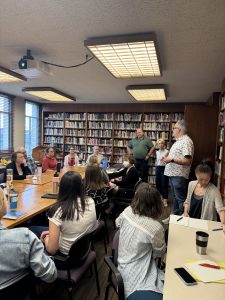
(This post contains spoilers for Cabaret.)
Following a co-hosted symposium on the Weimar Republic, the Guthrie generously invited the Center for Holocaust and Genocide Studies to attend a performance of Cabaret. We went last weekend, and it was simply exceptional. If you stop reading here, or take nothing else away from this post, see the show!
—
Act I. The play opens. “Wilkommen.” Soft chugging of a train as Cliff arrives in Berlin.
Act I of Cabaret is everything a real cabaret should be: decadent, sultry, and dazzlingly hedonistic. It is a modernized—and more carnal—version of Lautrec’s famed portraits of gaudy nightlife, but recontextualized through the sort of Brechtian self-awareness made possible by good directing. However, this illusion of the perfect cabaret splinters at the end of the act, when the Emcee recoils in horror as their gramophone begins playing an eerie and increasingly disconcerting “Tomorrow Belongs to Me.” As an audience, we sense a change; we just don’t know what it is yet.

